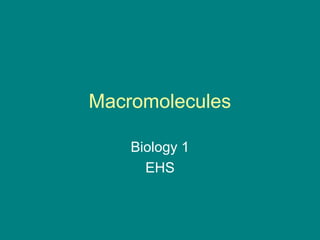
Macromolecules
- 2. The Chemistry of Carbon • Organic chemistry is the study of all compounds that contain bonds between carbon atoms. • A carbon atom can bond to other carbon atoms, giving it the ability to form chains that are almost unlimited in length.
- 3. – Living organisms are made of molecules that consist of carbon and other elements. – Carbon has the ability to form millions of different large and complex structures. – All life on earth is “carbon based”
- 4. Macromolecules – Macromolecules are formed by a process known as polymerization. – The smaller units, or monomers, join together to form polymers. – Monomer – smaller unit – Polymer – larger unit formed by linking monomers
- 5. • Macromolecules form by linking pieces like a chain.
- 6. – Four groups of organic compounds found in living things are: • • • • carbohydrates lipids nucleic acids proteins
- 7. Carbohydrates Carbohydrates • Carbohydrates are compounds made up of carbon, hydrogen, and oxygen atoms, usually in a ratio of 1 : 2 : 1. • C:H:O
- 8. – What is the function of carbohydrates?
- 9. – Living things use carbohydrates as their main source of energy.
- 10. – The breakdown of sugars, such as glucose, supplies immediate energy for all cell activities (ATP). – Living things store extra sugar as complex carbohydrates known as starches. – Glucose – the simplest sugar – Starches – complex sugars
- 11. – Starches and sugars are carbohydrates that are used by living things as a source of energy (ATP). Starch Glucose
- 12. – Monosaccharide – a single sugar (glucose) – Monosaccharides include glucose, galactose (a component of milk), and fructose (found in many fruits). – The large macromolecules formed from monosaccharides are called polysaccharides. – Mono – meaning one – Poly – meaning many
- 13. Lipids • Lipids are generally not soluble in water. (that means they don’t dissolve) • Lipids are made mostly from carbon and hydrogen atoms.
- 14. • The common categories of lipids are: • fats • oils • waxes • steroids
- 15. – What is the function of lipids?
- 16. – Lipids can be used to store energy. Some lipids are important parts of biological membranes and waterproof coverings.
- 17. – Many lipids are formed when a glycerol molecule combines with compounds called fatty acids. – The term saturated is used because the fatty acids contain the maximum possible number of hydrogen atoms.
- 18. – If there is at least one carbon-carbon double bond in a fatty acid, it is unsaturated.
- 20. Nucleic Acids • Nucleic Acids • Nucleic acids are macromolecules containing hydrogen, oxygen, nitrogen, carbon, and phosphorus. • Nucleic acids are polymers assembled from individual monomers known as nucleotides.
- 21. • Nucleotides consist of three parts: • a 5-carbon sugar • a phosphate group • a nitrogenous base
- 24. • What is the function of nucleic acids?
- 26. –Nucleic acids store and transmit hereditary, or genetic, information. –There are two kinds of nucleic acids, ribonucleic acid (RNA) and deoxyribonucleic acid (DNA). –RNA contains the sugar ribose. –DNA contains the sugar deoxyribose.
- 27. Proteins • Proteins • Proteins are macromolecules that contain nitrogen, carbon, hydrogen, and oxygen. • Proteins are polymers of molecules called amino acids.
- 28. – Amino acids are compounds with an amino group (-NH2) on one end and a carboxyl group (-COOH) on the other end.
- 31. – The portion of each amino acid that is different is a side chain called an R-group.
- 32. – The instructions for arranging amino acids into many different proteins are stored in DNA. Amino Acids Protein Molecule
- 33. – What is the function of proteins?
- 34. – Some proteins catalyze (control the rate of) reactions and regulate cell processes. • These proteins are called enzymes – Some proteins are used to form bones and muscles. – Other proteins transport substances into or out of cells or help to fight disease.
- 35. Enzymes • Almost all processes in the cell require enzymes in order to occur at proper rates. • Each enzyme is selective for a particular reaction. • Enzymes lower activation energy and increase the rate of reaction.
Notes de l'éditeur
- How many bonds can a carbon atom make? 4 Why- 4 valence electrons
- Use example of chlorophyll and the cause of leaves changing colors.
- When small molecules called monomers join together, they form polymers, or large molecules.
- ATP - adenosine triphosphate - created in the mitochondria of the cells
- Starches and sugars are examples of carbohydrates that are used by living things as a source of energy. Starches form when sugars join together in a long chain.
- High fructose corn syrup sucrose
- Nucleic acids store and transmit genetic information. The monomers that make up a nucleic acid are nucleotides. Each nucleotide has a 5-carbon sugar, a phosphate group, and a nitrogenous base.
- Amino acids are the monomers of proteins. All amino acids have an amino group at one end and a carboxyl group at the other end.
- Proteins help to carry out chemical reactions, transport small molecules in and out of cells, and fight diseases. Proteins are made up of chains of amino acids folded into complex structures.